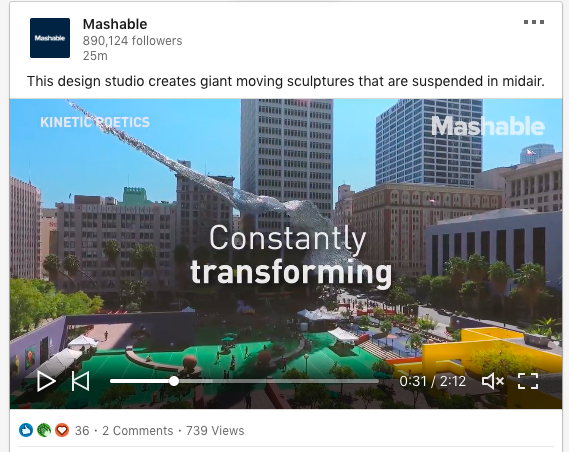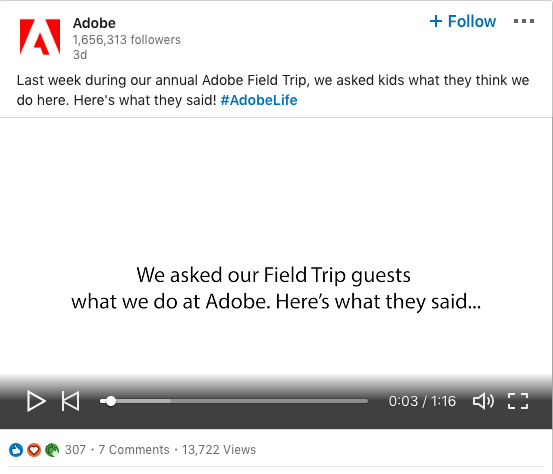LinkedIn can be a very engaging channel, especially for B2B brands. Here’s everything you need to know about the recent changes in the algorithm and how to create engaging content.
LinkedIn has turned into the number one platform for professionals and B2B brands. It’s been a social media platform with a consistent mission and it is attracting millions of people and brands who want to focus on professional relationship building.
Just a few months ago, Microsoft announced that there has been ‘record levels of engagement’ on LinkedIn seeing a Q1 growth of 24% for on-platform sessions. It’s not surprising then that more brands are investing time in updating their LinkedIn strategy over the last few years.
A good way to understand how LinkedIn works and how to improve your engagement is to look at their algorithm and their recent updates.
Understanding LinkedIn’s algorithm
LinkedIn has recently updated their algorithm that decides what shows up on our feeds. We might be talking more about Facebook’s algorithm when it comes to social media changes, but it’s still useful to understand how other platforms behave. When it comes to LinkedIn, what comes up on our feeds is based on their framework of ‘People You Know, Talking About Things You Care About.’
The most obvious posts that show up in your feed have to do with the people that you’re connected to or follow. There are also posts that your connections have liked, commented, shared that show up on your feed. Moreover, you can also see posts from groups, hashtags and topics that you follow.

The idea is to discover content that you care about. It’s not enough though to focus on relevance without the necessary value. The bigger the value, the higher the chances of seeing a post in your feed.
LinkedIn is relying on a machine learning algorithm that identifies the best conversations from all members that should show up to your feed. There is a two-pass architecture that ranks in the fraction of second thousands of posts to pick the most relevant ones for each member. The first pass rankers (FRP) are handling the preliminary selection that is based on predictive relevance (what they assume that you find relevant). For example, this selection can include updates from your connections, job ads and sponsored updates. The second pass ranker (SRP) combine all the preliminary scores to build a single list of ranking.
The FollowFeed is the main first pass ranker that brings tougher all the feed updates from your network and it includes more than 80% of your feed updates. In fact, these updates actually lead to more than 95% of the members’ conversations.
After an extensive series of tests and advanced machine learning features, LinkedIn is now focusing even more on the probability of contribution for the posts that show up on your feed. Thus, LinkedIn members see the content that they have more chances to share, comment, or react to.
To find out more technical details on LinkedIn’s algorithm, read their blog on their latest updates.
Focusing on engagement
LinkedIn is aiming to encourage participation and the rise of engagement in the platform comes from a series of changes to their algorithm. As with Facebook, ‘meaningful interactions’ are important to ensure that users are exposed to the most engaging content.
From a brand perspective, it’s very important to keep up with these changes to ensure that you’re creating engaging content.
It’s crucial to encourage conversations to increase the chances of having your content show up in more feeds.
You can start building the engagement through a series of steps
- Create posts that lead to conversations: don’t just share a link that you find interesting, ask a question and try to make it more engaging
- Encourage people to mention others: be creative with your content and encourage people to mention others who would find your posts interesting.
- Be part of existing conversations: use your personal profiles to join existing conversations and monitor your brand’s mentions to respond to them
- Use employee advocacy to reach a broader network: ask for help from your employees and their personal networks when sharing important content
- Create content that people want to share: tap into the psychology of a social media user and create content that is interesting enough for your audience to instantly share it
Improving your LinkedIn strategy
Pete Davies, Consumer Product at LinkedIn, has written an article sharing his own tips on how to improve your LinkedIn content strategy to get your posts to show up on users’ feeds.
Some of his tips include:
- Encourage conversations: the recent changes in LinkedIn’s algorithm make it imperative to create content that people will want to contribute to it. Aim for engagement that feels genuine.
- Pick niche over broad: think of your target audience and focus on your niche. You don’t need to share posts that are general as LinkedIn members seem to prefer niche topics they are interested in.
- Be authentic: authenticity can help you stand out with your content. Except for relevance and value, you also want to master your own tone of voice that will help you build a stronger community.
Moreover, we also see more brands adding to their LinkedIn strategy:
Videos
More brands are sharing videos and they tend to show up more frequently on our feeds over the last few months. Not all videos should be around campaigns, you can also share videos from your team, interesting interviews or even UGC that might be relevant.

Creative posts
There is a new trend on LinkedIn with posts that stand out with their creativity. How about sharing link posts that people won’t be able to ignore?

Hashtags
Hashtags have also had increased importance on LinkedIn especially when you want to improve your niche relevance.

When it comes to LinkedIn, what we need to remember when creating content is the reason why people are visiting the platform. People are visiting LinkedIn to connect with like-minded professionals. The content should be both interesting but also engaging to ensure that your brand stays relevant
The post How to master LinkedIn’s algorithm to boost engagement appeared first on Search Engine Watch.